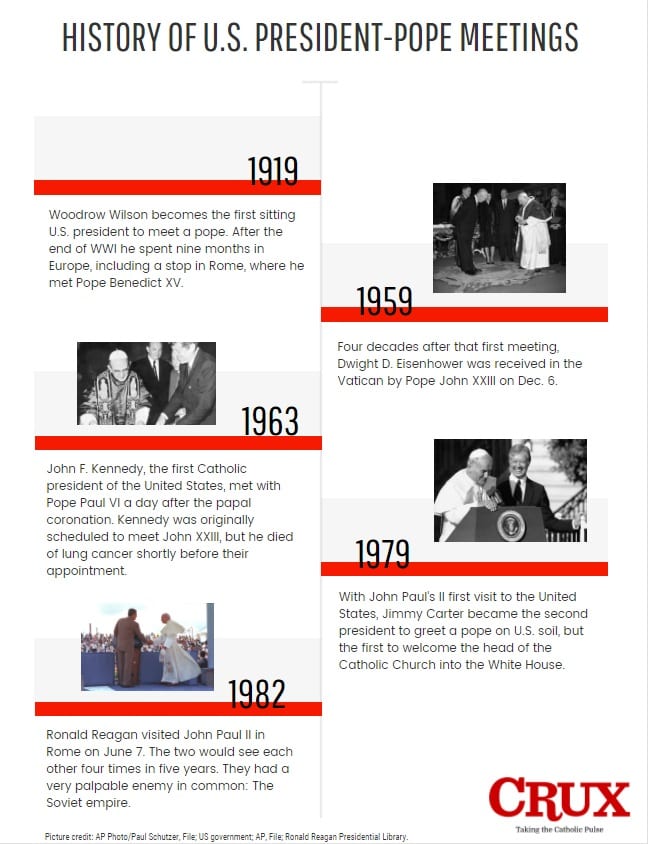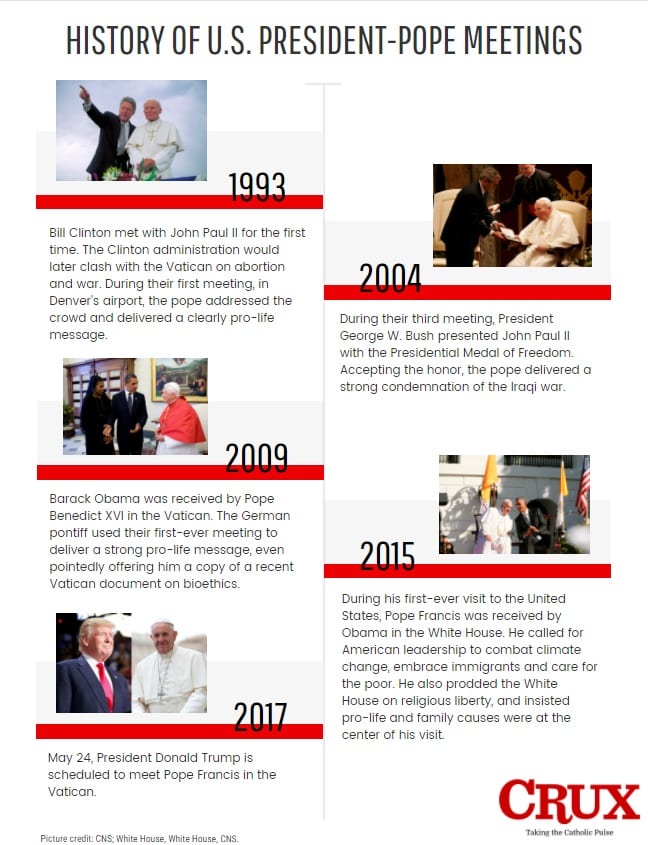ROME – Unless there’s an unexpected change in schedule – and, with these two mavericks, one never knows – Pope Francis and President Donald Trump will meet each other for the first time on Wednesday. The encounter will take place in the Vatican’s Apostolic Palace, where the pontiff meets most heads of state who visit him.
The two have spoken about each other, but this will be the first time they actually address one another directly.
This will not, however, be the first time a U.S. president and the pope meet. It won’t even be the first time Francis has encountered an American president, as he’s met with Barack Obama twice, once in Rome and once in Washington.
Ahead of Francis’s meeting with Trump, it’s worth looking back at previous times popes and presidents have intersected, and what was said about those meetings at the time.
That first time
The first sitting U.S. president to meet a pope was Woodrow Wilson, back on January 4, 1919. He encountered Benedict XV at the end of the First World War.
The first president to meet a pope was Ulysses S. Grant, who paid a visit to Pope Leo XIII in 1878, but it was after Grant had left office.
Theodore Roosevelt had an appointment with Pope Pius X for April 1910, but decided to skip it at the last minute due to his unwillingness to abide by the Vatican’s protocol.
President Franklin D. Roosevelt was the only sitting president since Wilson who, while visiting Italy, didn’t meet with the pope. It happened in 1943, when he traveled to the country to see Allied military installations as part of a November 20-December 9 tour that took him to several countries, including Malta, Senegal, Tunisia, and Egypt. Roosevelt wasn’t snubbing the pope: Rome was occupied by the Germans at the time, and the only part of Italy the president visited was Allied-occupied Sicily.
Back to Wilson.
According to Monsignor John Tracy Ellis, who wrote about the meeting in the biography Life of James Cardinal Gibbons, it was the pope who had requested the meeting, which took place during Wilson’s nine-month stay in Europe after the end of WWI.
Ellis writes that some time before the president’s departure, Gibbons, “as an American as well as a Catholic, as one who is bound to you by the bonds of patriotism as I am bound to the Holy Father in the bonds of religion,” requested Wilson visit the pontiff.
The pope’s intention was to have the Holy See included in the Treaty of Versailles, which in the end didn’t happen. Wilson cooperated with Italy to have the Holy See excluded from the peace conference – not the last time a pope was disappointed in a decision by an American president!
The second meeting, 40 years in the making
Dwight D. Eisenhower was welcomed by Pope John XXIII on December 6, 1959.

However, there were several high-level diplomatic exchanges between the Vatican and the United State’s government between Wilson’s meeting and Eisenhower’s. To note just one, in 1936, recently re-elected President Franklin D. Roosevelt received the papal secretary of state, Cardinal Eugenio Pacelli, who would become Pope Pius XII in March of 1939.
In 1939, Roosevelt sent Joseph Kennedy as his personal representative to the installation of Pius XII, and laid the groundwork to establish diplomatic relations with the Holy See by appointing a personal representative to the pope, who received the title of “extraordinary ambassador.”
At President Harry S. Truman’s request, former president Herbert Hoover visited Pope Pius XII in early 1946. According to the Hoover Presidential Library-Museum, the 71-year-old Hoover visited 38 nations in an effort to “beg, borrow and cajole enough food to avert mass starvation among victims of World War II.” He paused in Rome to secure Pope Pius’s blessing.
When Eisenhower arrived at the Vatican, he was received with all the dignity of a visiting head of state, despite the fact that at the time, the United States had no formal diplomatic relations with the Holy See. The Star-Spangled Banner was played in the St. Damasus Courtyard, and the papal secretary escorted the president and his entourage.
The Catholic president
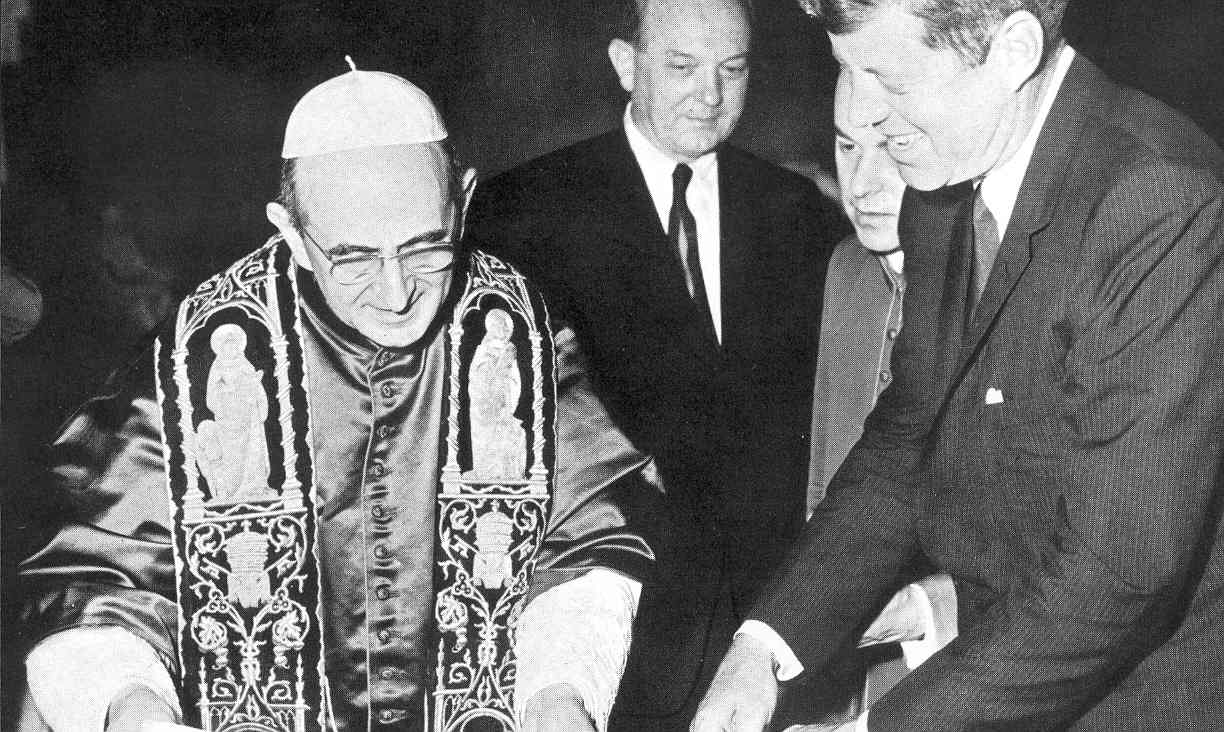
As the first Catholic president of the United States, John F. Kennedy, was careful to avoid any public appearance of favoring his church. During the campaign he was asked by reporters about his faith: “I believe in an America where the separation of church and state is absolute,” Kennedy said, “where no Catholic prelate would tell the president, should he be Catholic, how to act.”
It’s perhaps for this reason that he stalled the long process of rapprochement between America and the Vatican, ending the path which began when his father went to Pius XII’s inaugural Mass.
JFK was scheduled to visit West Germany in 1963, to bolster the country’s allegiance with the West and NATO. Before long, the original one-country itinerary grew to include Italy, Britain and Ireland.
Between the trip’s announcement and Kennedy’s arrival to Rome’s Fiumicino Airport in July 1, 1963, the Good Pope, John XXIII, died of stomach cancer.
Seeing how this event had shaken Italy, the president offered to cancel the visit altogether, but the Italian government insisted he didn’t. Instead, he delayed his arrival for July 1, the day after the coronation of Pope Paul VI, making sure not to coincide. The two met on July 2.
News reports from the time signal that the Catholic president left aside the usual Catholic etiquette: He neither knelt before nor kissed the ring of Paul VI, who spoke in English, without the need for an interpreter. Instead, the two shook hands.
The meeting was labeled as “informal, low-key and unofficial,” publicly announced as “private” and not an official state visit.
Both Wilson and Eisenhower had visited the Episcopal Church in Rome on the same day they met with the pope. Kennedy, however, skipped that visit, choosing instead to go to the North American College, where most U.S. seminarians live while studying in Rome.
Once there, he received from Cardinal Richard Cushing, at the time the Archbishop of Boston and a close friend of the Kennedy family, the gifts intended for him by late Pope John XXIII, including an autographed copy (one of three) of Pacem in Terris, his famous encyclical on universal peace in truth, justice, charity and liberty.
When Kennedy was assassinated a few months later, in November, Pope Paul took the unprecedented step of inviting an American TV crew (ABC) into the papal apartments, from where he spoke, in English, of his sorrow at “so dastardly a crime.” The following day, he also said Mass for Kennedy’s soul.
Lyndon B. Johnson, the first meeting outside of Rome
Two years after his meeting with Kennedy, Pope Paul VI became the first reigning pope to visit the United States. It was in New York City, on October 4, 1963, that he met with Johnson.
Paul VI had been invited to address the General Assembly of the United Nations. He decided to do so, leaving the fourth session of the Second Vatican Council to talk about disarmament and the fight against hunger, in many ways putting into practice the idea of “dialogue with the world,” of which he’d written in the encyclical Ecclesia Suam.
“No more war! War never again!” was the signature phrase from that speech.
Johnson wanted to meet the pope at the airport, but the pope wanted to make it clear that he was there as a guest of the United Nations, not the United States, so he refused. In the end, their 50-minute meeting took place in the president’s suite at the Waldorf-Astoria.
In 1967, the two met again, this time in the Vatican. Johnson was returning from a presidential visit to Saigon, and arrived at the Vatican by helicopter between 8:00 – 9:00 P.M, on December 23.
The stop was kept under wraps, even from the man receiving a visitor himself. Paul VI was, at the time hiding his own secret: A very hush-hush operation to treat an enlarged prostate.
The nearly impromptu visit lasted for over an hour, and afterwards Johnson released a statement speaking of the willingness to enter into negotiations with the North Vietnamese and to stop the bombing of that country, which he officially did in March of 1968.
Nixon, the president who flew to Rome twice in 8 days
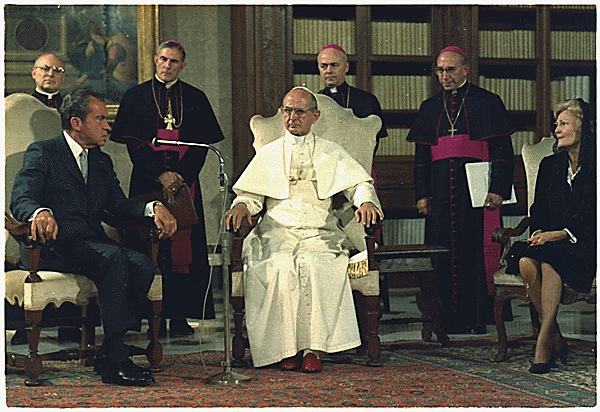
President Richard M. Nixon was visiting Western Europe in February-March of 1969. He had to fly to Rome twice during an eight-day visit because the pope had been on his Lenten retreat during Nixon’s first stay in Rome the week before.
The two talked for 75 minutes, during which time they reportedly discussed the process of the Vietnam peace talks, at the time underway in Paris. They also talked about the use of nuclear energy for peaceful purposes and aid to poor nations.
Rumors were abuzz at the time of Nixon sending an ambassador to the Holy See, with Nixon even mentioning the idea during a press conference. However, he only sent a personal envoy, as Roosevelt had done.
On September 28, 1970, Nixon would once again meet with Paul VI in Rome, for a meeting described as “less than pleasant, even acrimonious,” by Peter Hebblethwaite in his papal biography, Paul VI, the first modern pope.
Up next was president Gerald Ford, who met with Paul VI on June 3, 1975. The two met in private in the papal library for some 35 minutes, and then for another half-hour with Secretary of State Henry Kissinger, Ford wife’s, and other members of the entourage.
Jimmy Carter, the first president to welcome a pope to the White House
On October 6, 1979, Pope John Paul II visited the White House, as the highlight of his five-day visit to the United States. The week-long tour included six cities and 69 addresses.
The concerns that had arisen when Paul VI visited the UN, regarding the protocol for welcoming the head of state from a country with which the U.S. didn’t have diplomatic relations, were all but forgotten this time.
The two spoke in private for over an hour. According to Carter’s personal notes, available in the National Archives, they each drew on their strong Christian beliefs as they discussed the human rights situations across the world, including China, South Korea, and the Middle East.
“As human beings each acting for justice in the present — and striving together for a common future of peace and love — let us not wait so long for ourselves and for you to meet again. Welcome to our country, our new friend,” Carter said at the time.
In his reply, John Paul II said he wished to be “the messenger of peace and brotherhood, and a witness to the true greatness of every person.”
The two would meet again on June 21, 1980, when Carter visited the pope at the Vatican, and their conversation lasted 50 minutes.
Ronald Reagan, John Paul II, and their struggle against communism
Reagan visited John Paul II in Rome on June 7, 1982. It was one of the two visits Reagan made to the Vatican, and the two would see each other twice in the United States.
The two shared the dubious distinction of having suffered and survived assassination attempts, back in 1981, weeks apart from each other. They had much more than this in common, however, including the fact that both forgave their assailants and were both actors before taking the career paths that would make them key players of their time.

According to a recently released book by Paul Kengor, A Pope and a President: John Paul II, Ronald Reagan, and the Extraordinary Untold Story of the 20th Century, during that first meeting they both confided their conviction that God had spared their lives for the purpose of defeating Communism.
Two years later, on Jan. 10, 1984, the Holy See and the United States announced the establishment of full diplomatic relations, repealing the 1867 congressional legislation which had cut off all funding for an American representative to the Vatican.
William Wilson, a Catholic and close friend of Reagan, would be the first U.S. ambassador to the Vatican. Ever since, all of them have been Catholic.
Reagan and John Paul met again in 1984, in Alaska, and twice in 1987, first in the Vatican and then on American soil. That was the last time the two saw each other: Reagan was there to greet the pontiff as his plane landed in Miami in September 1987, extolling John Paul’s life and work.
“In Poland, you experienced Nazism and Communism,” Reagan said. “As pope, you suffered a terrorist attack that nearly claimed your life. Still, you proclaim that the central message of our time is not hatred but love.”
George H. W. Bush
The first Bush to be president had a somewhat less intense relationship with the Vatican than Reagan, with no joint fight against Communism to paper over any differences.
Bush met with John Paul II twice, both times in the Vatican. The first was on May 27, 1989, several months prior to the fall of the Berlin Wall, and then again on November 8, 1991, following the First Gulf War (January-February 1991).
This was a war the Polish Pope had personally tried to prevent through public statements and diplomatic channels, just as he tried to avoid Bush, Jr.’s invasion of Iraq over a decade later.
Bill Clinton, John Paul II and the pro-life matter
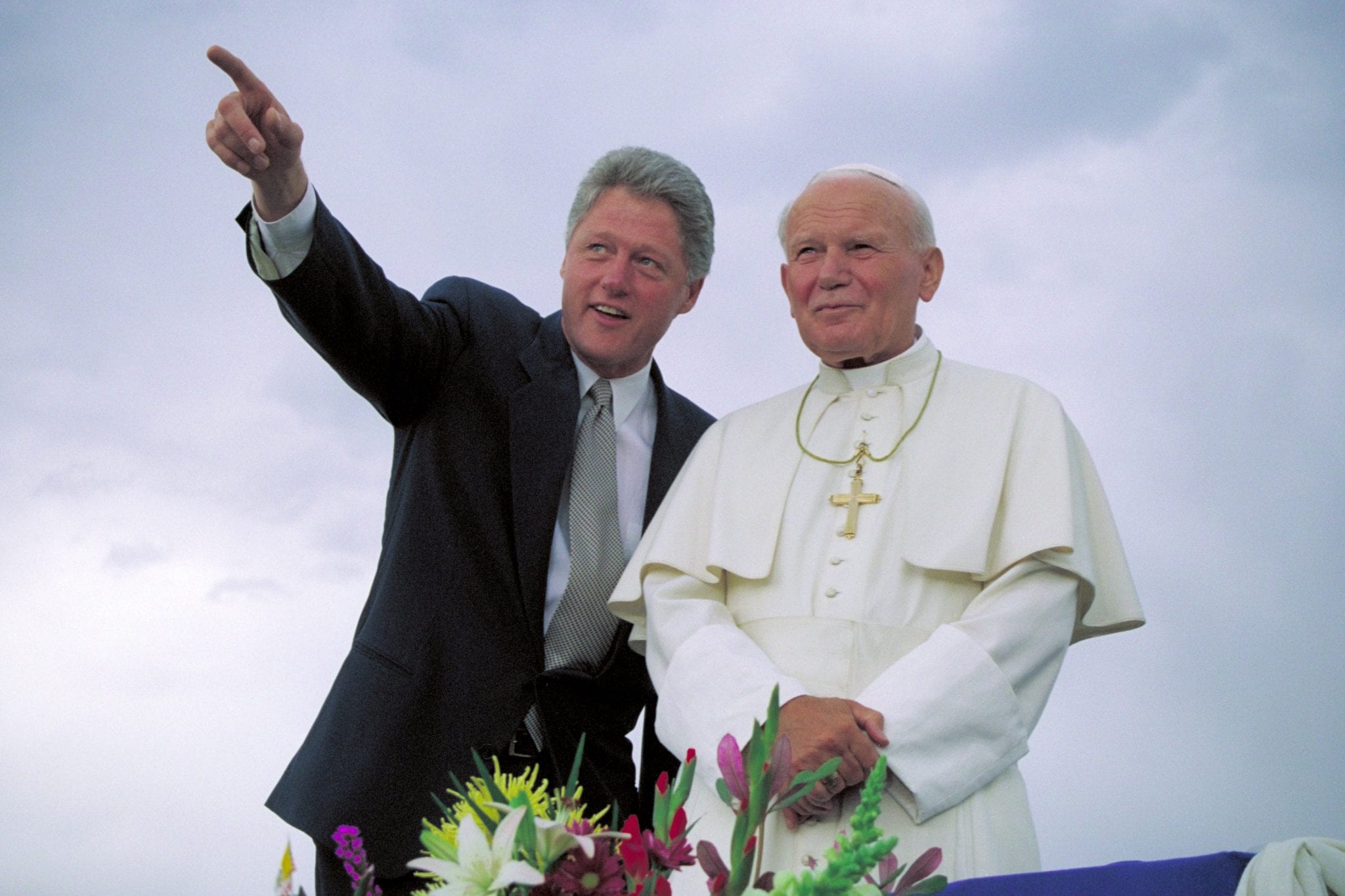
Clinton met with John Paul II three times on U.S. soil: Once in the Denver airport, in August 1993; in Newark, in October 1995; and in January 1999, in St. Louis.
The two met only once in the Vatican, on June 2, 1994.
The Clinton administration openly clashed with the Holy See on issues such as abortion and war. During that first meeting, in Denver, John Paul addressed the crowd, that included the president and his family, and delivered a clearly pro-life message.
“If you want equal justice for all and true freedom and lasting peace, then, America, defend life,” he said. “All the great causes that are yours today will have meaning only to the extent that you guarantee the right to life and protect the human person.”
By the time the two saw each other again, this time in Rome, the Clinton administration had made it clear that they wanted to make abortion a “legally enforceable universal human right,” something the U.S. bishops strongly condemned.
The six American cardinals at the time issued a letter deploring the Clinton administration’s “promotion of abortion, contraception, sterilization, and the redefinition of family.”
The six Roman trips of George W. Bush, plus the papal funeral
Bush traveled to the Vatican more than any other American president, being received by John Paul II on May 28, 2002 and again in June of 2004, when Bush presented the pope with the Presidential Medal of Freedom at the Vatican.
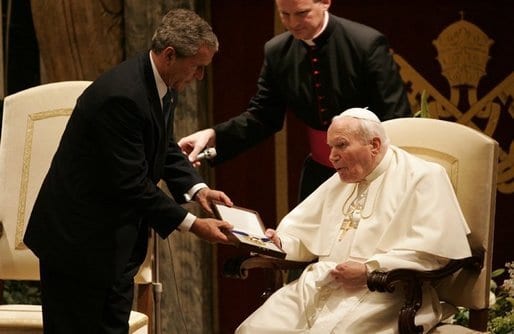
In 27 years, John Paul held more than a dozen meetings with U.S. presidents. One of the most famous — and most uncomfortable for an American leader — came in 2004 with Bush. The pontiff read a statement in English, and although his advanced Parkinson’s disease made it hard to understand for those listening in, it was a strong condemnation of the Iraq war.
“It is the evident desire of everyone that this situation now be normalized as quickly as possible with the active participation of the international community and, in particular, the United Nations organization, in order to ensure a speedy return of Iraq’s sovereignty, in conditions of security for all its people,” the pope said.
He also spoke about the “threat of international terrorism,” calling it a source of “constant concern,” that affected the relations between peoples “since the tragic date of 11 September 2001, which I have not hesitated to call ‘a dark day in the history of humanity.’”
Yet despite the criticism he received in this meeting, Bush had nothing but warm words to say about the pope: “For those of you who have ever met him, you know, I’m telling you the truth when I tell you, being in his presence is an awesome experience.”
It was the last time Pope John Paul II would receive an American president before his death in 2005.
When the Polish pope died, on April 2, 2005, Bush called for the U.S. flag to fly at half-staff throughout the nation, and attended the funeral together with two former presidents – Bush senior and Clinton – the first lady and the Secretary of State, Condoleezza Rice.
Bush also visited Pope Benedict XVI twice while in office, in June 2007 and June 2008.
The last time, Bush famously told the pope “Your eminence, you’re looking good,” using the title for cardinals, instead of the customary “your holiness.”
Benedict too was welcomed by Bush in the White House, on April 2008. The two differed on issues such as the Iraq war and capital punishment. Neither leader spoke about them in their public remarks. Bush did, however, allude to what the two have in common: Their opposition to abortion.
“In a world where some people treat life as something to be debased and discarded, we need your message that all human life is sacred,” Bush said.
Barack Obama, and his three meetings with two popes
Obama first shook hands with a pope on July 10, 2009, when he met Pope Benedict XVI in the Vatican. The German pontiff used his first-ever meeting with Obama to deliver a strong pro-life message, even pointedly offering him a copy of a recent Vatican document on bioethics.
Obama traveled with the first lady, their two children, and his mother in law.
In March 27, 2014, the American president travelled once again to Rome, this time to meet Pope Francis, in the papal library. The two spoke privately for almost an hour – with the help of an interpreter.

When they emerged from the meeting, the President and the Vatican had slightly different takes on the tenor of their discussions, especially when it came to issues that have frayed the relationship between the Obama administration and Church in the United States.
The meeting took place two days after the U.S. Supreme Court heard arguments on a contraception mandate included in Obama’s health care reform.
“In the context of bilateral relations and cooperation between Church and State, there was a discussion on questions of particular relevance for the Church in that country, such as the exercise of the rights to religious freedom, life and conscientious objection,” read the official Vatican statement about the meeting.
Talking to reporters, Obama said that these issues were “not a topic of conversation” with the pope, acknowledging instead that they had been discussed with the Vatican’s Secretary of State Pietro Parolin.
According to the Vatican, the two men also discussed the issue of immigration reform and “stated their common commitment to the eradication of human trafficking throughout the world.”
“I was grateful to have the opportunity to speak with him about the responsibilities that we all share to care for the least of these, the poor, the excluded,” Obama told reporters. “And I was extremely moved by his insights about the importance of us all having a moral perspective on world problems and not simply thinking in terms of our own narrow self-interests.”
The last meeting between an American president and a pope took place on September 23, 2015, when Obama welcomed Francis to the White House.
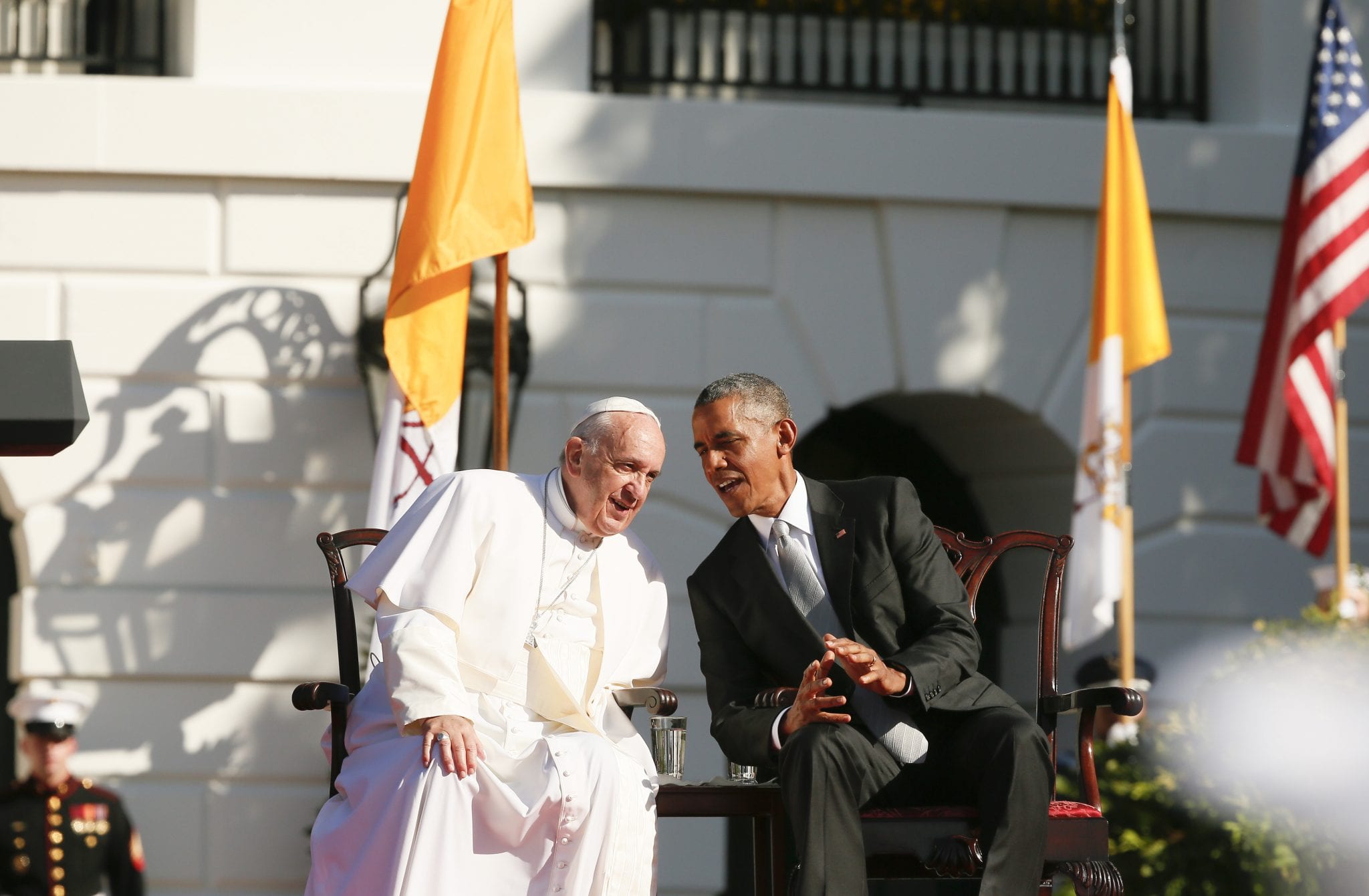
During his address in Washington, D.C., Francis called for American leadership to combat climate change, embrace immigrants, and care for the poor – showing agreement with Obama on several issues.
However, the pontiff also poked the White House on religious liberty, and insisted pro-life and family causes were at the center of his visit.
It’s impossible to predict what Trump and Francis will speak about on Wednesday.
However, based on history, it’s safe to say that despite disagreement on core issues, from the protection of life to war, presidents and popes have been able to do business by focusing on what the Argentine pope has called “open doors.”
